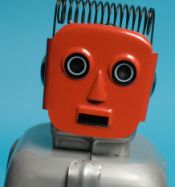Classic WTF: Tinfoil Hat Program
by in Feature Articles on 2007-12-31Although I've taken the rest of the year off, I wanted to share a few fun classics this week. "Tinfoil Hat Program" was originally published on 2005-05-24...
I had a pretty good post lined up today about (surprise, surprise) a rather peculiar abuse of HTML SELECTs. However, after reading the Tinfoil Hat House article posted at Slashdot, I knew I just had to share this project request that Mincus came across on one of those IT Project Portal sites (which I've certainly covered before).

 Nov 07
Nov 07 Ryan H was pretty excited to start his new job as a developer. But his excitement quickly faded after he started. It didn't fade into apprehension, disappointment, or regret -- just into nothing; he simply stopped feeling anything at all. This type of apathy is to be expected when one is given the type of assignment that Ryan was given: absolutely nothing. Ryan's day to day job was to sit and patiently wait for the company to start up a project.
Ryan H was pretty excited to start his new job as a developer. But his excitement quickly faded after he started. It didn't fade into apprehension, disappointment, or regret -- just into nothing; he simply stopped feeling anything at all. This type of apathy is to be expected when one is given the type of assignment that Ryan was given: absolutely nothing. Ryan's day to day job was to sit and patiently wait for the company to start up a project.  M.A. is one of the world's foremost experts on neural networks. His undergraduate specialty was artificial intelligence, his master's thesis was about genetic algorithms, and his doctoral dissertation covered evolutionary programming. Such an extensive computer science education opened up a wide range of career options, ranging from a professor at a university to ... a professor at another university. When someone outside of academia sought out his expertise for a project, he jumped at the opportunity.
M.A. is one of the world's foremost experts on neural networks. His undergraduate specialty was artificial intelligence, his master's thesis was about genetic algorithms, and his doctoral dissertation covered evolutionary programming. Such an extensive computer science education opened up a wide range of career options, ranging from a professor at a university to ... a professor at another university. When someone outside of academia sought out his expertise for a project, he jumped at the opportunity. When I first shared the story of
When I first shared the story of  By the time he was twenty-one, Roy had already earned the title "drop out." College just wasn't his thing: he attended three different universities -- one after another -- and didn't even come close to earning a degree. His "drop out" title was only solidified when he started work as a roll-machine operator at the local paper factory. Worse yet, the factory was by the docks, which meant that Roy had to pass through the outdoor fish-market every day on his way to work. Talk about a great way to start the day. But Roy wasn't fazed; he became inspired.
By the time he was twenty-one, Roy had already earned the title "drop out." College just wasn't his thing: he attended three different universities -- one after another -- and didn't even come close to earning a degree. His "drop out" title was only solidified when he started work as a roll-machine operator at the local paper factory. Worse yet, the factory was by the docks, which meant that Roy had to pass through the outdoor fish-market every day on his way to work. Talk about a great way to start the day. But Roy wasn't fazed; he became inspired.  It was only 9:15 in the morning and Neal was ready to write the day off as a complete loss. Neal's day started off with him accidentally pressing the "Alarm Off" button instead of "Snooze," missing his morning workout, driving downtown through the tail-end of a traffic jam, and arriving forty-five minutes late to work. But when he stepped in the office, it was oddly vacant: Was it a company holiday? Did he miss the field trip memo? Was today actually a Saturday? "Neal," the president shouted from his corner office, interrupting Neal's workless fantasy, "get in here; come see this!"
It was only 9:15 in the morning and Neal was ready to write the day off as a complete loss. Neal's day started off with him accidentally pressing the "Alarm Off" button instead of "Snooze," missing his morning workout, driving downtown through the tail-end of a traffic jam, and arriving forty-five minutes late to work. But when he stepped in the office, it was oddly vacant: Was it a company holiday? Did he miss the field trip memo? Was today actually a Saturday? "Neal," the president shouted from his corner office, interrupting Neal's workless fantasy, "get in here; come see this!"  At the turn of the 21st century, Initrode Global's server infrastructure began showing cracks. Anyone that had been in the server room could immediately tell that its growth had been organic. Rackmounted servers sat next to recommissioned workstations, with cables barely secured by cable ties. Clearly there had been some effort to clean things up a bit, but whoever put forth that effort gave up halfway through.
At the turn of the 21st century, Initrode Global's server infrastructure began showing cracks. Anyone that had been in the server room could immediately tell that its growth had been organic. Rackmounted servers sat next to recommissioned workstations, with cables barely secured by cable ties. Clearly there had been some effort to clean things up a bit, but whoever put forth that effort gave up halfway through. Christian R. was in trouble. Despite his experience across hardware and software, desktops and server clusters, thumb drives and SANs, he hadn't found any freelance work in weeks. It was clear that he'd have to figure something out to pay the bills.
Christian R. was in trouble. Despite his experience across hardware and software, desktops and server clusters, thumb drives and SANs, he hadn't found any freelance work in weeks. It was clear that he'd have to figure something out to pay the bills. After 18 long months, it was finally time to celebrate. David M. and his fellow dev team members received word that their latest build had passed QA testing and was ready for delivery.
After 18 long months, it was finally time to celebrate. David M. and his fellow dev team members received word that their latest build had passed QA testing and was ready for delivery.  R. Young got his first job as a developer right out of college. He was a Programmer Consultant I, which meant that he'd be sent to a client site to fix bugs in some old system. But on his first assignment, he got lucky: the client actually wanted him and the junior-level programmer to develop a small application.
R. Young got his first job as a developer right out of college. He was a Programmer Consultant I, which meant that he'd be sent to a client site to fix bugs in some old system. But on his first assignment, he got lucky: the client actually wanted him and the junior-level programmer to develop a small application.